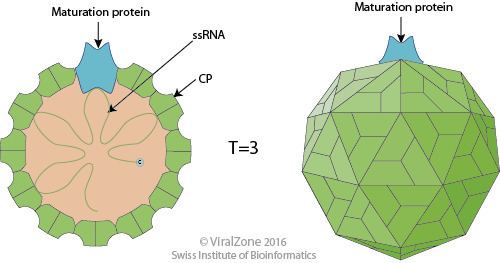Group Group IV ((+)ssRNA) Rank Family | Higher classification Caudovirales | |
 | ||
Similar Corticovirus, Cystovirus, Tectivirus, Microviridae, Plasmaviridae | ||
Medical vocabulary what does leviviridae mean
Leviviridae is a family of viruses. Bacteria, including Enterobacteria, Caulobacter, Pseudomonas, and Acinetobacter serve as natural hosts for these bacteriophages. There are currently four species in this family, divided among 2 genera. They are small RNA viruses with linear, positive-sense, single-stranded RNA genomes that encode only four proteins. All phages of this family require bacterial pili to attach to and infect cells.
Contents
Medical vocabulary what does leviviridae mean
Taxonomy
The family has two genera, both of which currently have two known species.
Group: ssRNA(+)
Structure
Viruses in Leviviridae are non-enveloped, with icosahedral and Spherical geometries, and T=3 symmetry. The diameter is around 26 nm. Genomes are linear and non-segmented, around 4kb in length. The genome codes for 4 proteins.
Life Cycle
Entry into the host cell is achieved by adsorption into the host cell. Replication follows the positive stranded RNA virus replication model. Positive stranded RNA virus transcription is the method of transcription. Translation takes place by suppression of termination. The virus exits the host cell by bacteria lysis. Enterobacteria, caulobacter, pseudomonas, and acinetobacter serve as the natural host.
Genome
The four proteins encoded are the coat, replicase, maturation and lysis proteins.
